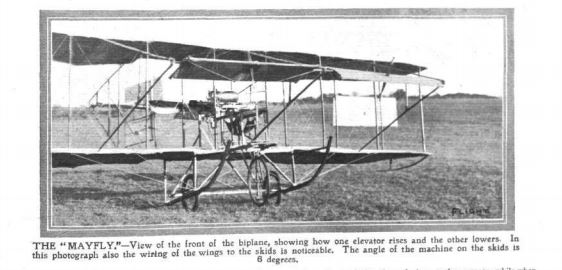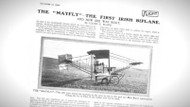Lilian Bland: Ireland's First Female Pilot Could Do It All
By on Jul 3rd 2017
In reality, though, Lilian Bland was truly anything BUT bland.
It's true that Lilian Bland was the first woman to fly a plane in Ireland. But it's also true that she was so much more than just a pilot. She was the first woman in the world to both design and build her very own aircraft (which she flew). Her aircraft, which she dubbed
Mayfly, was actually the first powered biplane in Ireland.
Lilian Bland, born September 8, 1878, was someone who succeeded in just about everything she did. Every time she wanted to learn how to do something, she did. And everything she did, she did well. Under normal circumstances, her accomplishments would certainly be worthy of celebration. But given her position as a woman at the turn of the century, her accomplishments were particularly noteworthy.
She was a photographer. She was a journalist. She was an excellent horsewoman. She was a pilot. She was a car dealer. She is a legend.
Prior to Flight
Lilian was unconventional, to say the least. She smoked, wore trousers, fished, hunted, and enjoyed all manners of life that were typically more masculine. When it came to hunting, she had an excellent shot. She had a wonderful way with horses and was one of the first women to apply for a jockey's license. In fact, her riding was so top-notch and talent so great she was prepared to ride in the Grand National, a National Hunt horse race in England. She was refused entry, however, for being a woman (women wouldn't be able to enter until 1977 with the passing of the Sex Discrimination Act in 1975).
As with just about everything else, Lilian's interest in photography also proved to be one of her many talents and she excelled in the field. Professionally, she took up journalism with photography and was drawn to sports photography. She contributed work to London papers and eventually took on nature photography. She used her love of capturing movement to photograph birds flying over the coast of Scotland. These photos were exhibited at London's Royal Photographic Society, and may just be the first color plate images of live birds ever taken.
Aviation Career
Lillian's next interest was inspired by a postcard of the Blriot monoplane sent from her uncle in Paris. In 1909,
Louis Blriot made the first flight across the English Channel in an aircraft. At this point in history, powered flight in Ireland didn't exist yet (and wouldn't until Harry Ferguson took slight December 31, 1909). In order to fly, she surmised she would have to build her own aircraft, which she did. After reading up on the Wright Brothers a bit, and taking notes on the first British aviation meeting in Blackpool in October 1909, she got to work building her own flyable, proof-of-concept model.
At the time Lilian Bland began her adventures in aviation,
Amelia Earhart was only 12 years old.
For the construction of her full-scale biplane glider, she chose bamboo, ash, spruce, and elm as the wooden elements. She created the wings to imitate those of seagulls by steaming ash to replicate their curved wingtips. The wing spars and skids were ash, the ribs and interplane struts were spruce, outriggers were bamboo, and the engine mounting was American Elm. The wings were covered in unbleached calico.
She dubbed her aircraft the -Mayfly- (as in it
may fly, or it may not fly).

Mayfly
The aircraft was steered using a bicycle handlebar and pedals controlled the vertical rudder. She tested the glider (the plane didn't yet have an engine) at Carnmoney Hill in early 1910. This initial (unmanned) flight was successful, as were subsequent flights where she made perfections. During these tests, she perfected her takeoff and landings. She also made some modification to enable an engine.
Bland purchased a 20hp two-stroke engine from A. V. Roe & Co., but she faced delays in receiving the fuel tank. To make up for this delay, she devised a temporary fuel system which consisted of a whiskey bottle and an ear trumpet. She described the sound as -a cat-fight on a very enlarged scale- when she tested it. Some locals thought the mill had blown up and as the noise continued, then thought it was a thunderstorm.
Trials of her powered aircraft took place at the Deerpark in Randalstown. A free-roaming bull (named Ferdinand) provided additional (and unwanted) motivation to get her biplane off the ground.
On August 31, 1910, the conditions were perfect for flying. The aircraft did a lot of hopping and the engine was very shaky, causing damage to the plane.
The weather wasn't suitable for more flights until September. Bland used this time to reinforce the aircraft's structure and make additional adjustments. With Bland as the pilot, the aircraft made the first of several motor-powered flights rising to approximately 30 feet high and traveling for a quarter mile. She described the event:
I could hardly believe it. After each flight, I ran back to see where the wheel tracks left the grass, to convince myself that I really had been airborne.
Lilian Bland, completely hooked on aviation, declared flying as "the finest sport in the world."
With her love and success of flying, Lilian was also motivated to start an aviation company. She advertised her improved aircraft (advertised as 'May-fly'), standard or racing, from £250 (without engine).
Later Life
Not everyone was in love with her newfound obsession, especially her family who found it troubling. They worried about her safety and, to convince her to stop, her anxious father offered her a Ford Model T automobile if she agreed to abandon flight.
She agreed. She had accomplished what she had set out to do and saw the limitations of her design compared to larger companies with greater resources. Motor cars were just a new adventure (and a more powerful machine).
After she purchased her car in Dublin, she managed to convince the delivery driver to let her drive the car. Much like it was with flying (and every other hobby) she quickly fell in love and mastered the skill of driving. She loved it so much that she became a car dealer for Ford Motors in April 1911.
Selling cars was, naturally, very unladylike and her family arranged a marriage proposal. She married her cousin, Charles Loftus Bland of Vancouver Island, In October 1911. She emigrated to Canada and together had one daughter, Patrica Lilian, who died of tetanus in 1929. In 1935, Bland returned to UK and settled in Kent. In the 1950s she retired to Cornwall. She died there on May 11, 1971, at the age of 92.
Lilian Bland is commemorated by an Ulster History Circle blue plaque at the family home at Carnmoney.
Sources:
http://news.bbc.co.uk/local/cornwall/hi/people_and_places/history/newsid_8956000/8956919.stm
http://www.belfasttelegraph.co.uk/life/features/journalist-photographer-crackshot-and-the-first-woman-to-fly-an-aeroplane-the-amazing-lilian-bland-28552187.html
Frey, Holly and Tracy V. Wilson. -Aviatrix Lilian Bland.- Stuff You Missed in History Class. Podcast. 13 July 2016. Web. 10 June 2017.
https://en.wikipedia.org/wiki/Bland_Mayfly
http://www.engineersjournal.ie/2016/05/31/lilian-bland-first-female-aviation-engineer/
http://www.historyireland.com/20th-century-contemporary-history/from-the-files-of-the-dib/







